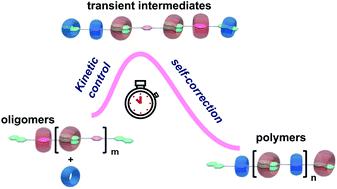当前位置:
X-MOL 学术
›
Chem. Sci.
›
论文详情
Our official English website, www.x-mol.net, welcomes your
feedback! (Note: you will need to create a separate account there.)
Supramolecular copolymerization through self-correction of non-polymerizable transient intermediates
Chemical Science ( IF 7.6 ) Pub Date : 2022-06-17 , DOI: 10.1039/d2sc01930b Ganyu Chen 1 , Peichen Shi 1 , Longhui Zeng 1 , Liubin Feng 1 , Xiuxiu Wang 1 , Xujing Lin 1 , Yibin Sun 1 , Hongxun Fang 1 , Xiaoyu Cao 1 , Xinchang Wang 2 , Liulin Yang 1 , Zhongqun Tian 1
Chemical Science ( IF 7.6 ) Pub Date : 2022-06-17 , DOI: 10.1039/d2sc01930b Ganyu Chen 1 , Peichen Shi 1 , Longhui Zeng 1 , Liubin Feng 1 , Xiuxiu Wang 1 , Xujing Lin 1 , Yibin Sun 1 , Hongxun Fang 1 , Xiaoyu Cao 1 , Xinchang Wang 2 , Liulin Yang 1 , Zhongqun Tian 1
Affiliation

|
Kinetic control over structures and functions of complex assembly systems has aroused widespread interest. Understanding the complex pathway and transient intermediates is helpful to decipher how multiple components evolve into complex assemblies. However, for supramolecular polymerizations, thorough and quantitative kinetic analysis is often overlooked. Challenges remain in collecting the information of structure and content of transient intermediates in situ with high temporal and spatial resolution. Here, the unsolved evolution mechanism of a classical self-sorting supramolecular copolymerization system was addressed by employing multidimensional NMR techniques coupled with a microfluidic technique. Unexpected complex pathways were revealed and quantitatively analyzed. A counterintuitive pathway involving polymerization through the ‘error-correction’ of non-polymerizable transient intermediates was identified. Moreover, a ‘non-classical’ step-growth polymerization process controlled by the self-sorting mechanism was unraveled based on the kinetic study. Realizing the existence of transient intermediates during self-sorting can encourage the exploitation of this strategy to construct kinetic steady state assembly systems. Moreover, the strategy of coupling a microfluidic technique with various characterization techniques can provide a kinetic analysis toolkit for versatile assembly systems. The combined approach of coupling thermodynamic and kinetic analyses is indispensable for understanding the assembly mechanisms, the rules of emergence, and the engineering of complex assembly systems.
中文翻译:

通过不可聚合瞬态中间体的自校正实现超分子共聚
对复杂装配系统的结构和功能的动力学控制引起了广泛的兴趣。了解复杂的途径和瞬态中间体有助于破译多个组件如何演变成复杂的组件。然而,对于超分子聚合,彻底和定量的动力学分析往往被忽视。在原位收集瞬态中间体的结构和含量信息方面仍然存在挑战具有很高的时间和空间分辨率。在这里,通过采用多维核磁共振技术与微流体技术相结合,解决了经典自分类超分子共聚体系的未解决演化机制。揭示并定量分析了意想不到的复杂途径。确定了一种违反直觉的途径,涉及通过不可聚合瞬态中间体的“纠错”进行聚合。此外,基于动力学研究,揭示了由自分类机制控制的“非经典”逐步增长聚合过程。在自分选过程中实现瞬态中间体的存在可以鼓励利用这种策略来构建动力学稳态装配系统。而且,将微流体技术与各种表征技术相结合的策略可以为多功能装配系统提供动力学分析工具包。耦合热力学和动力学分析的组合方法对于理解装配机制、出现规则和复杂装配系统的工程是必不可少的。
更新日期:2022-06-17
中文翻译:

通过不可聚合瞬态中间体的自校正实现超分子共聚
对复杂装配系统的结构和功能的动力学控制引起了广泛的兴趣。了解复杂的途径和瞬态中间体有助于破译多个组件如何演变成复杂的组件。然而,对于超分子聚合,彻底和定量的动力学分析往往被忽视。在原位收集瞬态中间体的结构和含量信息方面仍然存在挑战具有很高的时间和空间分辨率。在这里,通过采用多维核磁共振技术与微流体技术相结合,解决了经典自分类超分子共聚体系的未解决演化机制。揭示并定量分析了意想不到的复杂途径。确定了一种违反直觉的途径,涉及通过不可聚合瞬态中间体的“纠错”进行聚合。此外,基于动力学研究,揭示了由自分类机制控制的“非经典”逐步增长聚合过程。在自分选过程中实现瞬态中间体的存在可以鼓励利用这种策略来构建动力学稳态装配系统。而且,将微流体技术与各种表征技术相结合的策略可以为多功能装配系统提供动力学分析工具包。耦合热力学和动力学分析的组合方法对于理解装配机制、出现规则和复杂装配系统的工程是必不可少的。











































 京公网安备 11010802027423号
京公网安备 11010802027423号